At 27th and 28th of October, the Kick-off for the "Kultur-Hackathon" Coding da Vinci is held in Mainz, Germany, organized this time by GLAM institutions from the Rhein-Main area: "For five weeks, devoted fans of culture and hacking alike will prototype, code and design to make open cultural data come alive." New software applications are enabled by free and open data.
For the first time, ZBW is among the data providers. It contributes the person and company dossiers of the 20th Century Press Archive. For about a hundred years, the predecessor organizations of ZBW in Kiel and Hamburg had collected press clippings, business reports and other material about a wide range of political, economic and social topics, about persons, organizations, wares, events and general subjects. During a project funded by the German Research Organization (DFG), the documents published up to 1948 (about 5,7 million pages) had been digitized and are made publicly accessible with according metadata, until recently solely in the "Pressemappe 20. Jahrhundert" (PM20) web application. Additionally, the dossiers - for example about Mahatma Gandhi or the Hamburg-Bremer Afrika Linie - can be loaded into a web viewer.
As a first step to open up this unique source of data for various communities, ZBW has decided to put the complete PM20 metadata* under a CC-Zero license, which allows free reuse in all contexts. For our Coding da Vinci contribution, we have prepared all person and company dossiers which already contain documents. The dossiers are interlinked among each other. Controlled vocabularies (for, e.g., "country", or "field of activity") provide multi-dimensional access to the data. Most of the persons and a good share of organizations were linked to GND identifiers. As a starter, we had mapped dossiers to Wikidata according to existing GND IDs. That allows to run queries for PM20 dossiers completely on Wikidata, making use of all the good stuff there. An example query shows the birth places of PM20 economists on a map, enriched with images from Wikimedia commons. The initial mapping was much extended by fantastic semi-automatic and manual mapping efforts by the Wikidata community. So currently more than 80 % of the dossiers about - often rather prominent - PM20 persons are linked not only to Wikidata, but also connected to Wikipedia pages. That offers great opportunities for mash-ups to further data sources, and we are looking forward to what the "Coding da Vinci" crowd may make out of these opportunities.
Technically, the data has been converted from an internal intermediate format to still quite experimental RDF and loaded into a SPARQL endpoint. There it was enriched with data from Wikidata and extracted with a construct query. We have decided to transform it to JSON-LD for publication (following practices recommended by our hbz colleagues). So developers can use the data as "plain old JSON", with the plethora of web tools available for this, while linked data enthusiasts can utilize sophisticated Semantic Web tools by applying the provided JSON-LD context. In order to make the dataset discoverable and reusable for future research, we published it persistently at zenodo.org. With it, we provide examples and data documentation. A GitHub repository gives you additional code examples and a way to address issues and suggestions.
* For the scanned documents, the legal regulations apply - ZBW cannot assign licenses here.


